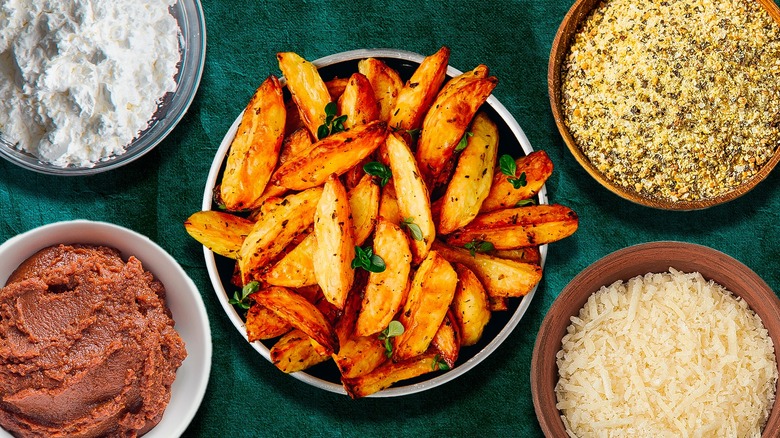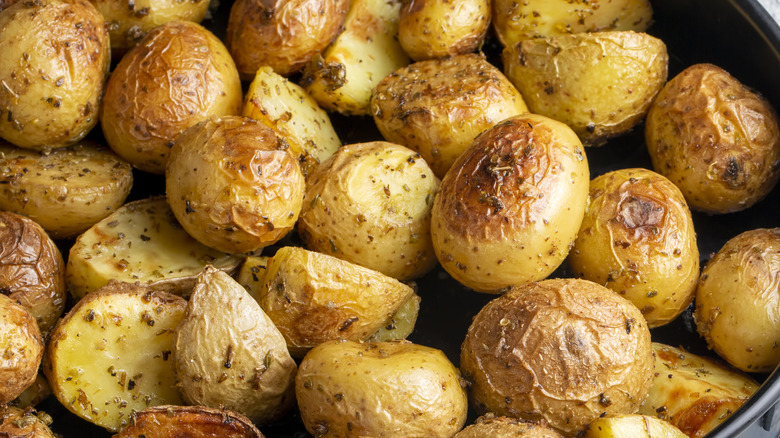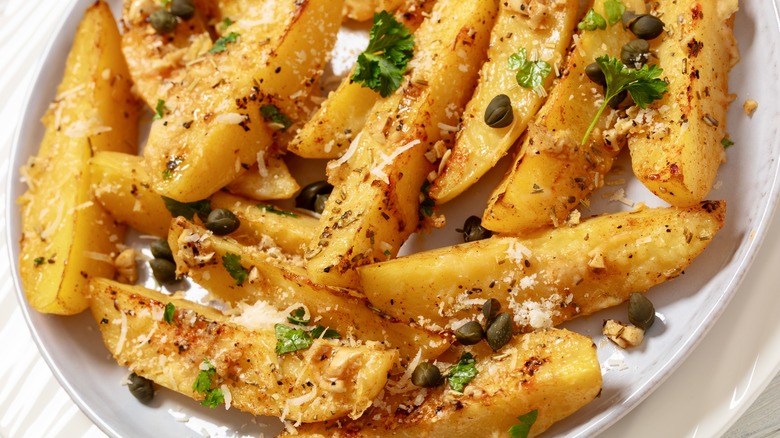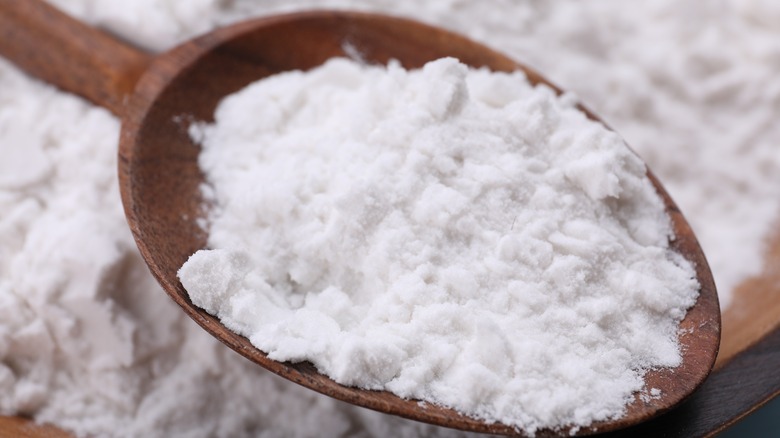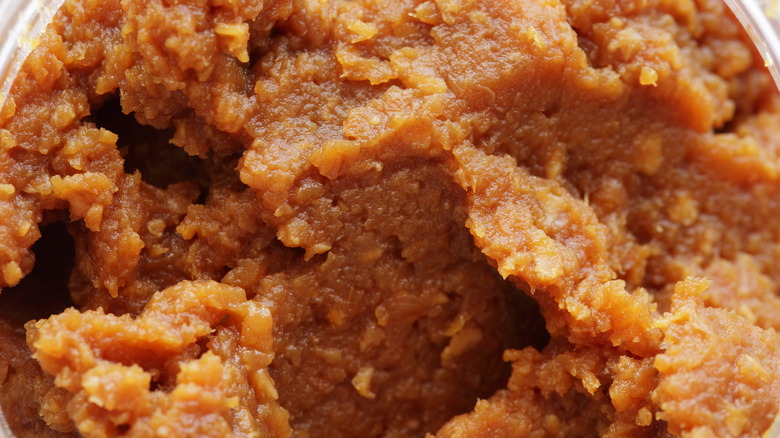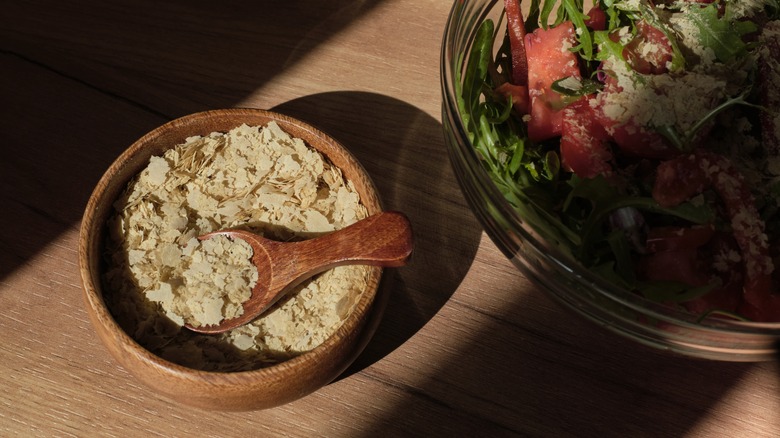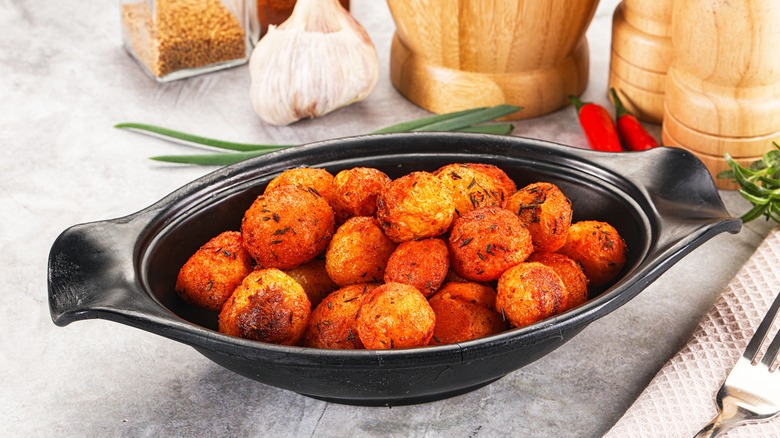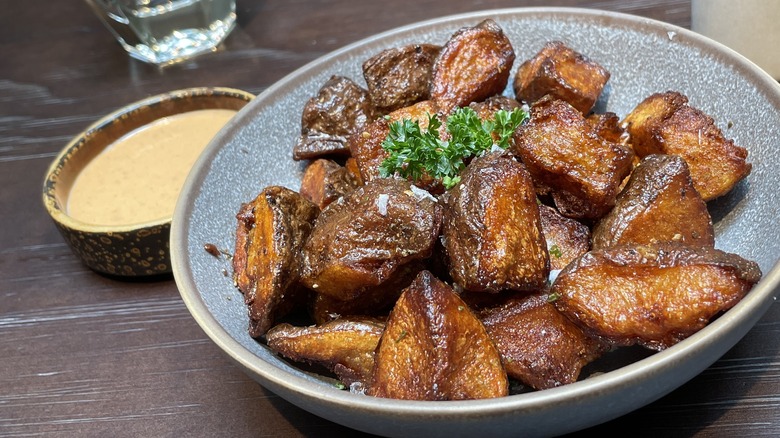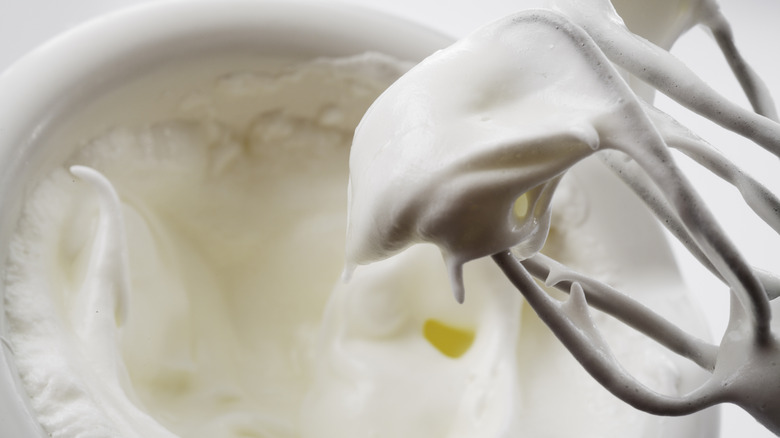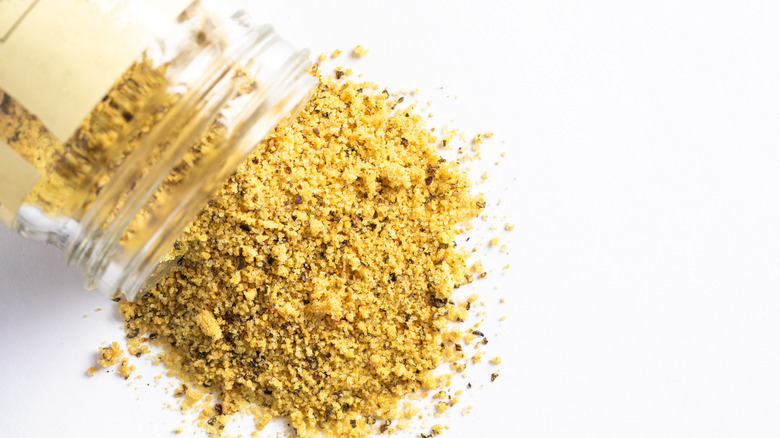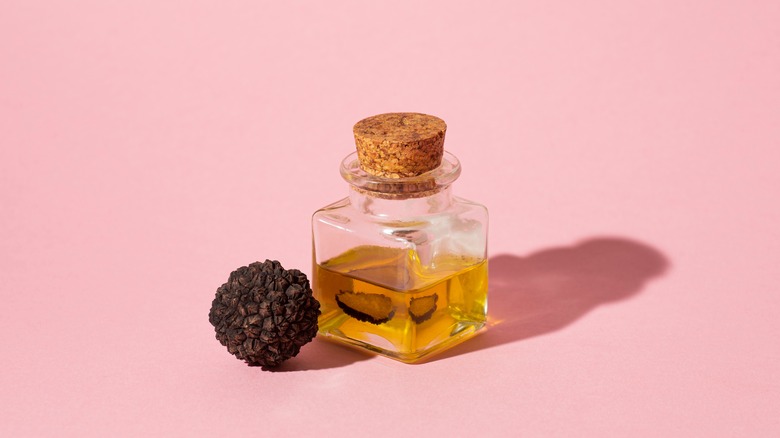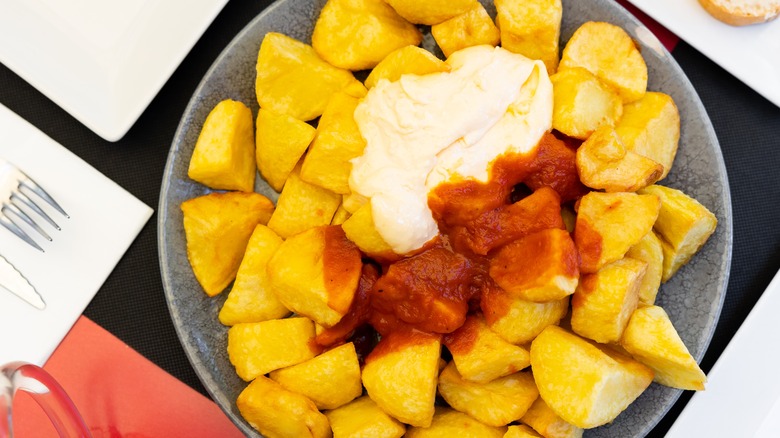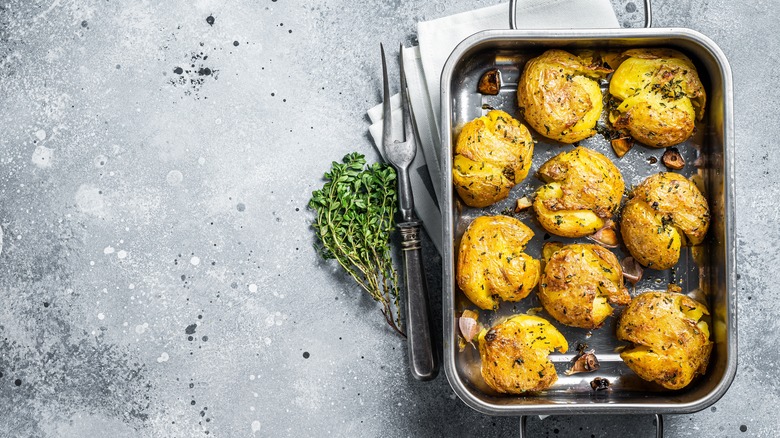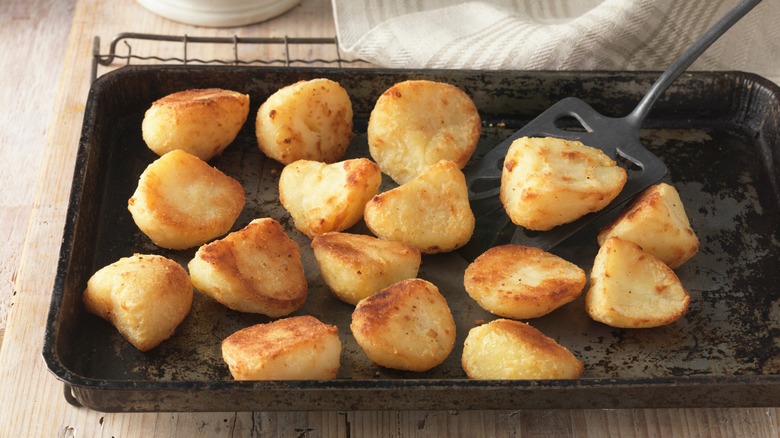Secret Ingredients You Need To Start Adding To Roasted Potatoes
The perfect roasted potato is a study in contrasts: crispy on the outside, fluffy on the inside, and bursting with hot, concentrated spud flavor. Yet attaining this nirvana of a side dish seems like a fool's journey, full of potential limp and watery pieces — or at least, nothing that crackles when you bite into it.
There's some science behind it, for sure. When potatoes are exposed to high heat — ideally, anywhere between 425 F and 450 F — the water inside them begins to evaporate. This process helps produce that crispy exterior we crave. At the same time, a complex chemical reaction called the Maillard reaction begins to occur between amino acids and the reducing sugars inside the spud. This is what we call "browning," and it helps attain that gorgeous brown color and savory taste of perfectly executed roasted potatoes. Finally, the starch granules inside the potato absorb water and swell, creating a soft, fluffy interior.
Sound complex? Luckily, there are a few secret ingredients that can help this process and add amazing flavor to take your roasted potatoes to steakhouse levels. They range from the familiar (Parmesan and duck fat) to the kind of ingredients that will have your friends asking you for the recipe — and then not believing the answers. If you've never tried potatoes with miso paste or salsa, prepare to be amazed.
Garlic powder
Garlic powder is a convenient way to add a big burst of garlic flavor to your roasted potatoes without the risk of burning that comes with fresh garlic. This oft-overlooked seasoning offers a concentrated, uniform garlic taste that permeates every bite of your crispy spuds.
As you probably know if you've tried making garlic roasted potatoes, fresh garlic can burn and become bitter at high roasted temperatures. In contrast, garlic powder maintains its flavor throughout the cooking process.
For best results, toss your potatoes with oil and garlic powder or garlic salt in a large bowl before roasting. This helps distribute the seasoning evenly across your sheet of potatoes to infuse them with a savory, aromatic taste. The powder's fine texture allows it to adhere to the surface of the potatoes much better than minced garlic, helping create a flavorful crust as it roasts.
Parmesan cheese
Long considered one of the best ingredients in Italian cuisine, Parmigiano Reggiano adds a nutty, salty and umami-rich flavor to roasted potatoes. Its high salt content helps to draw out moisture, contributing to a crispier salty exterior that is not unlike french fries.
When it heats up, Parmesan's natural glutamates enhance the savory flavor of the potatoes, creating a more complex taste. You can mix the cheese with woodsy fresh or dried herbs to cut through the richness. To make Parmesan roast potatoes, add the grated cheese in the last 10 minutes of cooking. This allows the cheese to melt slightly and form a crispy, golden crust on the potatoes without burning.
Before running to the kitchen and grabbing that green-red bottle of cheese flakes, take heed that not all Parmesan cheese you cook with is Parmigiano Reggiano. Genuine Parmigiano Reggiano cheese carries a Protected Designation of Origin (PDO, or DOP in Italian) certification, which certifies that the cheese before you is produced exclusively in certain regions of Italy using traditional methods. When shopping for Parmigiano Reggiano, keep an eye out for the PDO/DOP label on the packaging as a guarantee of strict quality standards and production regulations.
Cornstarch or baking soda
The next entry may sound like something from a science experiment, but we swear that using cornstarch or baking soda to coat your roasted potatoes is going to change how you view these humble white powders. Usually used as thickeners or rising agents, cornstarch and baking soda can also be used as a coating to give vegetables and proteins a crispy exterior.
Cornstarch contains a high percentage of a starch molecule called amylose. As it dehydrates and crisps in the oven, the starch forms a thin coating on the outside of the potatoes, resulting in a satisfyingly crunch outer layer. This technique is particularly effective for achieving that contrast between exterior crunch and interior fluffiness, which is why it is often used in commercial french fries to give them that gorgeous crispy coating.
On the other hand, baking soda works its magic during the parboiling stage. Adding a pinch of baking soda to the cooking water when parboiling potatoes works to raise their pH levels. This causes the exterior of the potatoes to break down even more, creating more surface area that can come in contact with the hot oil and air in the oven. This helps the potato crisp up more uniformly, rather than in patches.
For the ultimate results, both methods can be combined. First, use baking soda in the parboiling water, then coat the potatoes with cornstarch before roasting, and you're well on your way to roasted potato heaven.
Miso paste
Miso paste is a fermented soybean product that adds a deep, savory umami flavor to roasted potatoes. Regularly used in Japanese cuisine, this secret ingredient has the power to add burst of flavor to your potatoes unlike any other.
Not all miso is created equal. White miso offers a milder flavor, while red or brown miso provides a stronger, more intense taste. Avoid very pungent miso, like buckwheat, as it can greatly overshadow your potatoes. To use miso paste, start by mixing a teaspoon of it with your chosen oil before tossing with the potatoes. Taste and add more if needed. Miso has a very strong flavor, and a little of it can go a long way, so err on the side of caution with this ingredient.
When it cooks, the miso caramelizes slightly in the oven, creating a rich, complex flavor profile that permeates the entire potato. The saltiness and umami of the miso complement the potatoes' natural earthiness, while its slight sweetness enhances their natural sugars. For an extra flavor boost, consider combining miso with other ingredients like sesame oil, or even garlic and ginger. Because miso can burn at high temperatures, roast the potatoes at a slightly lower temperature, about 400 F, or add the miso mixture halfway through cooking. And whatever you do, avoid adding more salt. The saltiness of miso is more than enough for flavoring your dish.
Nutritional yeast
Nutritional yeast is so much more than just a gimmick used in vegan cooking — though, no, it won't make your bread rise. A deactivated a yeast that is rich in nutrients, nutritional yeast has a cheesy, nutty flavor not dissimilar to Parmesan and makes for a fantastic addition to roasted potatoes.
To harness the flavor of nutritional yeast, all you need to do is sprinkle it on your parboiled potatoes before roasting for a boost of savory flavor, an appetizing yellowish hue and a slightly crispy coating. To make it stick to the potatoes even better, mix it with a small amount of oil. As it roasts, nutritional yeast forms a flavorful crust on the potatoes, though it won't crisp them up as well as cornstarch.
But nutritional yeast's beauty goes beyond its unique flavor. It is packed with B-vitamins, including B12, which means it'll give your side dish a much-needed nutritional boost. For the best flavor, pair this ingredient with herbs like sage, rosemary or thyme.
Smoked paprika
Smoked paprika, also known as pimentón, adds a subtle smoky flavor and a beautiful red color to potatoes. It typically comes from Spain, where it's made from mild Capsicum peppers, dried, and smoked using a wood-based fire. This process imbues the seasoning with a complex, smoky and pungent flavor that translates beautifully to vegetables and meats.
Adding smoked paprika to roast potatoes is one of those additions that can completely change how you make this dish. Just one teaspoon of this finely ground seasoning mixed into your roasting oil or butter imparts a nuanced flavor profile that combines sweetness with smokiness and even a mild, very gentle heat. You can also sprinkle the paprika over the potatoes in the last 10 minutes of roasting for a more robust flavor.
Smoked paprika adds depth and complexity to roasted potatoes that makes them a perfect accompaniment to grilled meats. It also pairs particularly well with garlic and olive oil for a Spanish-inspired flavor profile. So next time you want to add a unique twist to your roasted potatoes, reach for that forgotten jar of smoked paprika for an unexpected kick.
Duck fat
It's no great secret that potatoes love duck fat. Prized by chefs for its rich flavor and high smoke point, this oil is ideal for roasting potatoes. It imparts a luxurious, savory taste and helps create an exceptionally crispy exterior that's hard to achieve with other fats. (It also works really well for latkes, in case you were looking for another potato dish.)
Duck fat has a high smoke point, which means you can roast at higher temperatures without worrying about the fat burning. This results in potatoes that are crispy on the outside and fluffy on the inside. While duck fat is high in saturated fat, it also contains monounsaturated fat and linoleic acid, which some studies suggest may have health benefits.
To use duck fat, melt it in the microwave or a saucepan. Then, toss it with your parboiled potatoes before roasting. This method results in golden-brown potatoes with a decadent flavor that pair with roast duck or other poultry dishes.
Another approach with duck fat is to make double smashed potatoes. After parboiling your potatoes, toss them to coat in the duck fat and roast for 20 minutes. Then, press the potatoes with a wooden spoon or a potato masher, flattening them up into 1-inch patties. Proceed to sprinkle a bit more duck fat and flaky sea salt on top before roasting for another 10 minutes for an unbelievably crispy side.
Egg whites
Coating potatoes in egg whites before roasting is a lesser-known technique that can yield incredibly crispy results, forever ruining you from all other potato preparation methods. This works because the proteins in egg whites form a thin layer on the exterior of the potatoes as they cook. The egg whites help to both bind other toppings to the potatoes and to crisp up their outside into a crunchy, thin outer layer that shatters upon contact with your teeth. The contrast between this and the potatoes' soft interior is the stuff that makes angels sing.
To use this method, whisk egg whites in a large bowl until they are frothy. Then, toss the parboiled potatoes in the mixture before roasting. For an extra punch of flavor, opt for a double-coat method, following up the egg whites with a coating of seasonings like garlic powder and herbs, and then a small amount of cornstarch. This method works particularly well as a low-fat alternative to traditional roasted potatoes because it saves you from using any oil. Keep in mind that egg-white-coated potatoes may burn more quickly, so lower the temperature to 400 F and keep an eye on them during roasting, checking on them every 10 minutes.
Lemon pepper seasoning (or lemon zest)
Lemon pepper is a forgotten vintage seasoning with a bright, zesty flavor that has the power to lighten up the traditionally heavy side of roast potatoes. Lemon's citrusy notes complement the earthy flavor of the potatoes, while the black pepper adds a subtle heat that underscores the lemon's high notes.
The good news is that you don't have to go searching for commercial lemon pepper; this seasoning is incredibly easy to make at home. Simply zest a whole lemon and mix it with a pinch of salt and a teaspoon of coarsely ground black peppercorns. Toss the potatoes with the seasoning and oil before roasting, which will work to concentrate the flavors and infuse the potatoes as they cook. You can also add a squeeze of lemon juice after roasting for a burst of extra fresh citrus flavor. Pair these lemony potatoes with whole fish or chicken for a Mediterranean-inspired meal, even going so far as throwing in herbs like oregano and thyme.
Truffle oil
For truly upscale potatoes, try adding a drizzle of truffle oil to your roasting pan. The intense, earthy aroma of this fungi-tinged oil adds depth and sophistication to the potatoes, making them a meal worthy of the highest company. But before you go replacing your butter with truffle oil, remember that this condiment is especially pungent. Use it sparingly, and in combination with other fats — a little truly goes a long way here.
In case you're not aware, there likely aren't actually any truffles in your truffle oil. Originally infused with black or white truffles in order to lower their price, most of today's truffle oil derives its flavor from synthetic ingredients, making it the object of hatred for some vociferous chefs. But true truffle oil is still around, and we find that this is one ingredient that is worth seeking out and paying top dollar. The flavor of real truffle oil can actually truly bump up the earthiness of the potatoes and turn this humdrum comfort food into something luxe.
For the best flavor, drizzle a small amount of truffle oil over the potatoes after roasting, or mix a teaspoon or two with your regular cooking oil prior to sending the potatoes into the oven. Truffle-infused potatoes pair well with beef dishes or mushroom-filled vegetarian entrees.
Salsa
Salsa and potatoes may sound unconventional, but this pairing can create a deliciously zesty and spicy side dish. Salsa-tossed potatoes make for juicy, flavorful morsels with a hint of bright, citrusy spice.
To make salsa-roasted potatoes, drain your favorite salsa from excess liquid using cheesecloth or a paper towel-lined colander. Toss parboiled potatoes in the salsa prior to roasting. The tomatoes, onions, and peppers in the salsa will caramelize in the oven, intensifying their flavors and concentrating their natural sugars. Or you can do as they do in Spain and make patatas bravas. For this dish, simply roast potatoes and top them with aioli and a tangy tomato sauce after baking.
Salsa roasted potatoes work just as well with smooth and chunky salsas, so don't be afraid to experiment. It makes for a great filling for tacos, or a side dish for carnitas.
Rosemary and thyme
In case you couldn't tell by how often we mentioned them, rosemary and thyme are classic herbs that traditionally pair with roasted potatoes. This combination comes from rustic French cuisine, with these aromatic seasonings infusing the potatoes with their fragrant oils during the roasting process.
Though dried herbs may be easier to source, we urge you to go to the source and use fresh herbs when roasting your potatoes. Mix them with the spuds and oil or duck fat prior to cooking, and then arrange evenly on a baking sheet or a roasting pan. As they roast, the heat works to release the essential oils in the herbs, permeating the potatoes with flavor and aroma.
As befitting a French-inspired dish, this herb combination works well with homey dishes like lamb, roast chicken and grilled vegetables. When using fresh rosemary and thyme, strip the leaves from the stems and chop them finely before mixing with the potatoes. You can also toss whole sprigs among the potatoes for additional aroma, but remember to remove them before serving.
For an extra flavor boost, crush some of the herbs with salt in a mortar and pestle before sprinkling them over the potatoes. This releases even more of their natural oils, making the dish as aromatic as possible. The woodsy, slightly piney flavor of rosemary along the minty flavor of thyme are a match-made-in-heaven for the earthy potatoes.
Beef drippings
Last but certainly not least, try the unexpected twist of adding beef drippings to upgrade your roasted potatoes. Beef drippings are the juices and fat rendered from roasting beef, and as such, they are packed with rich, meaty flavor.
The intense umami flavor of beef drippings in combination with the potatoes works to create a side dish that's practically a meal in itself. The high heat of roasting causes the proteins and sugars in the drippings to caramelize, forming a crispy, flavorful crust that is the perfect coating for our roast. To use beef drippings, either roast your potatoes in the same pan as your beef roast, allowing them to cook in the drippings, or collect the drippings and toss your potatoes in them before roasting separately.
Beef drippings are naturally quite rich and salty, so you may want to reduce or eliminate any additional salt in your seasoning. For an extra-indulgent treat, go wild and use a combination of beef drippings and duck fat for an incredibly rich flavor and a supreme crispy exterior.
